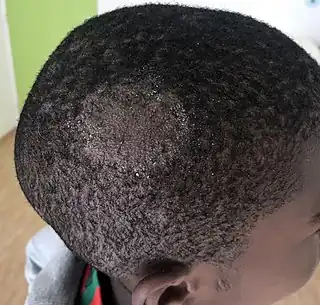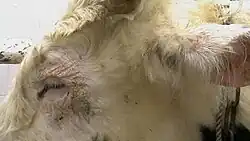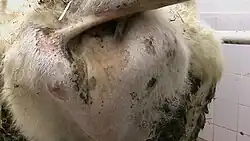Dermatophytosis
| Dermatophytosis | |
|---|---|
| Other names: Tinea, ringworm[1] | |
 .jpg.webp) | |
| Top: Dermatophytosis of scalp Bottom: Athlete foot | |
| Specialty | Dermatology, infectious diseases[2] |
| Symptoms | Red, itchy, scaly, circular skin rash[3] |
| Causes | Fungi: Microsporum, Epidermophyton, Trichophyton[3] |
| Risk factors | Using public showers, contact sports, excessive sweating, contact with animals, obesity, poor immune function[4][5] |
| Diagnostic method | Based on symptoms, microbial culture, microscopic examination[6] |
| Differential diagnosis | Dermatitis, psoriasis, pityriasis rosea, tinea versicolor[7] |
| Prevention | Keep the skin dry, no walking barefoot in public, not sharing personal items[4] |
| Treatment | Antifungal creams (clotrimazole, miconazole)[8] |
| Frequency | 20% of the population[9] |
Dermatophytosis, also known as tinea and ringworm, is a fungal infection of the outer layer of skin, hair, or nails, typically caused by Trichophyton, Microsporum, or Epidermophyton.[1][2] It tends to result in a red, itchy, scaly, circular rash.[10] Hair loss may occur in the area affected.[10] Symptoms begin 4 to 14 days after exposure.[10] It includes dermatophyte infections of the head, body, hands, feet, groin, beard, and nails.[3]
About 40 types of fungi can cause ringworm.[11] Risk factors include using public showers, contact sports such as wrestling, excessive sweating, contact with animals, obesity, and poor immune function.[4][5] It can spread from other animals or between people.[4] Diagnosis is often based on the appearance and symptoms.[6] It may be confirmed by either culturing or looking at a skin scraping under a microscope.[6]
Prevention is by keeping the skin dry, not walking barefoot in public, and not sharing personal items.[4] Treatment is typically with antifungal creams such as clotrimazole or miconazole.[8] If the scalp is involved, antifungals by mouth such as fluconazole may be needed.[8]
Globally, up to 20% of the population may be infected by ringworm at any given time.[9] Infections of the groin are more common in males, while infections of the scalp and body occur equally in both sexes.[5] Infections of the scalp are most common in children while infections of the groin are most common in the elderly.[5] Descriptions of ringworm date back to ancient history.[12]
Signs and symptoms
Infections on the body may give rise to typical enlarging raised red rings of ringworm. Infection on the skin of the feet may cause athlete's foot and in the groin, jock itch. Involvement of the nails is termed onychomycosis, and they may thicken, discolour, and finally crumble and fall off. They are common in most adult people, with up to 20% of the population having one of these infections at any given moment.
Specific signs can be:
- red, scaly, itchy or raised patches
- patches may be redder on outside edges or resemble a ring
- patches that begin to ooze or develop a blister
- bald patches may develop when the scalp is affected
- nails may thicken, discolour or begin to crack[13]
.jpg.webp) Tinea pedis (feet)
Tinea pedis (feet) Tinea corporis (localised on body)
Tinea corporis (localised on body).jpg.webp) Tinea corporis (widerspread on body)
Tinea corporis (widerspread on body).jpg.webp) Tinea cruris (groin)
Tinea cruris (groin).jpg.webp) Tinea manuum (hands)
Tinea manuum (hands).jpg.webp) Tinea capitis (head
Tinea capitis (head.jpg.webp) Tinea barbae (beard)
Tinea barbae (beard).jpg.webp) Onychomycosis
Onychomycosis
Causes
It is typically caused by Trichophyton, Microsporum, or Epidermophyton.[1][2]
Risk factors include using public showers, contact sports such as wrestling, excessive sweating, contact with animals, obesity, and poor immune function.[4][5] It can spread from other animals or between people.[4]
Diagnosis
Classification
A number of different species of fungi are involved in dermatophytosis. Dermatophytes of the genera Trichophyton and Microsporum are the most common causative agents. These fungi attack various parts of the body and lead to the conditions listed below. The Latin names are for the conditions (disease patterns), not the agents that cause them. The disease patterns below identify the type of fungus that causes them only in the cases listed:
Other superficial mycoses (not classic ringworm, since not caused by dermatophytes)
- Tinea versicolor: caused by Malassezia furfur[14]
- Tinea nigra: caused by Hortaea werneckii
Prevention
Advice often given includes:
- Avoid sharing clothing, sports equipment, towels, or sheets.
- Wash clothes in hot water with fungicidal soap after suspected exposure to ringworm.
- Avoid walking barefoot; instead wear appropriate protective shoes in locker rooms and sandals at the beach.[15][16][17]
- Avoid touching pets with bald spots, as they are often carriers of the fungus.
Vaccination
As of 2016, no approved human vaccine exist against Dermatophytosis. For horses, dogs and cats there is available an approved inactivated vaccine called Insol Dermatophyton (Boehringer Ingelheim) which provides time-limited protection against several trichophyton and microsporum fungal strains.[18] With cattle, systemic vaccination has achieved effective control of ringworm. Since 1979 a Russian live vaccine (LFT 130) and later on a Czechoslovakian live vaccine against bovine ringworm has been used. In Scandinavian countries vaccination programmes against ringworm are used as a preventive measure to improve the hide quality. In Russia, fur-bearing animals (silver fox, foxes, polar foxes) and rabbits have also been treated with vaccines.[19]
Treatment
Antifungal treatments include topical agents such as miconazole, terbinafine, clotrimazole, ketoconazole, or tolnaftate applied twice daily until symptoms resolve — usually within one or two weeks.[20] Topical treatments should then be continued for a further 7 days after resolution of visible symptoms to prevent recurrence.[20][21] The total duration of treatment is therefore generally two weeks,[22][23] but may be as long as three.[24]
In more severe cases or scalp ringworm, systemic treatment with oral medications may be given.[25]
To prevent spreading the infection, lesions should not be touched, and good hygiene maintained with washing of hands and the body.[26]
Misdiagnosis and treatment of ringworm with a topical steroid, a standard treatment of the superficially similar pityriasis rosea, can result in tinea incognito, a condition where ringworm fungus grows without typical features, such as a distinctive raised border.
History
Dermatophytosis has been prevalent since before 1906, at which time ringworm was treated with compounds of mercury or sometimes sulfur or iodine. Hairy areas of skin were considered too difficult to treat, so the scalp was treated with X-rays and followed up with antifungal medication.[27] Another treatment from around the same time was application of Araroba powder.[28]
Terminology
The most common term for the infection, "ringworm", is a misnomer, since the condition is caused by fungi of several different species and not by parasitic worms.
Other animals
Ringworm caused by Trichophyton verrucosum is a frequent clinical condition in cattle. Young animals are more frequently affected. The lesions are located on the head, neck, tail, and perineum.[29] The typical lesion is a round, whitish crust. Multiple lesions may coalesce in "map-like" appearance.
Clinical dermatophytosis is also diagnosed in sheep, dogs, cats, and horses. Causative agents, besides Trichophyton verrucosum, are T. mentagrophytes, T. equinum, Microsporum gypseum, M. canis, and M. nanum.[30]
Dermatophytosis may also be present in the holotype of the Cretaceous eutriconodont mammal Spinolestes, suggesting a Mesozoic origin for this disease.
Animals such as dogs and cats can also be affected by ringworm, and the disease can be transmitted between animals and humans, making it a zoonotic disease.
 Multiple lesions, head
Multiple lesions, head Around the eyes and on ears
Around the eyes and on ears On cheeks: crusted lesion (right)
On cheeks: crusted lesion (right) Old lesions, with regrowing hair
Old lesions, with regrowing hair On neck and withers
On neck and withers On perineum
On perineum
Diagnosis
Ringworm in pets may often be asymptomatic, resulting in a carrier condition which infects other pets. In some cases, the disease only appears when the animal develops an immunodeficiency condition. Circular bare patches on the skin suggest the diagnosis, but no lesion is truly specific to the fungus. Similar patches may result from allergies, sarcoptic mange, and other conditions. Three species of fungi cause 95% of dermatophytosis in pets: these are Microsporum canis, Microsporum gypseum, and Trichophyton mentagrophytes.
Veterinarians have several tests to identify ringworm infection and identify the fungal species that cause it:
Woods test: This is an ultraviolet light with a magnifying lens. Only 50% of M. canis will show up as an apple-green fluorescence on hair shafts, under the UV light. The other fungi do not show. The fluorescent material is not the fungus itself (which does not fluoresce), but rather an excretory product of the fungus which sticks to hairs. Infected skin does not fluoresce.
Microscopic test: The veterinarian takes hairs from around the infected area and places them in a staining solution to view under the microscope. Fungal spores may be viewed directly on hair shafts. This technique identifies a fungal infection in about 40%–70% of the infections, but cannot identify the species of dermatophyte.
Culture test: This is the most effective, but also the most time-consuming, way to determine if ringworm is on a pet. In this test, the veterinarian collects hairs from the pet, or else collects fungal spores from the pet's hair with a toothbrush, or other instrument, and inoculates fungal media for culture. These cultures can be brushed with transparent tape and then read by the veterinarian using a microscope, or can be sent to a pathological lab. The three common types of fungi which commonly cause pet ringworm can be identified by their characteristic spores. These are different-appearing macroconidia in the two common species of Microspora, and typical microconidia in Trichophyton infections.[30]
Identifying the species of fungi involved in pet infections can be helpful in controlling the source of infection. M. canis, despite its name, occurs more commonly in domestic cats, and 98% of cat infections are with this organism. It can also infect dogs and humans, however. T. mentagrophytes has a major reservoir in rodents, but can also infect pet rabbits, dogs, and horses. M. gypseum is a soil organism and is often contracted from gardens and other such places. Besides humans, it may infect rodents, dogs, cats, horses, cattle, and swine.[31]
Treatment
Pets
Treatment requires both systemic oral treatment with most of the same drugs used in humans—terbinafine, fluconazole, or itraconazole—as well as a topical "dip" therapy.[32]
Because of the usually longer hair shafts in pets compared to those of humans, the area of infection and possibly all of the longer hair of the pet must be clipped to decrease the load of fungal spores clinging to the pet's hair shafts. However, close shaving is usually not done because nicking the skin facilitates further skin infection.
Twice-weekly bathing of the pet with diluted lime sulfur dip solution is effective in eradicating fungal spores. This must continue for 3 to 8 weeks.[33]
Washing of household hard surfaces with 1:10 household sodium hypochlorite bleach solution is effective in killing spores, but it is too irritating to be used directly on hair and skin.
Pet hair must be rigorously removed from all household surfaces, and then the vacuum cleaner bag, and perhaps even the vacuum cleaner itself, discarded when this has been done repeatedly. Removal of all hair is important, since spores may survive 12 months or even as long as two years on hair clinging to surfaces.[34]
Cattle
In bovines, an infestation is difficult to cure, as systemic treatment is uneconomical. Local treatment with iodine compounds is time-consuming, as it needs scraping of crusty lesions. Moreover, it must be carefully conducted using gloves, lest the worker become infested.
See also
References
- 1 2 3 "ICD-11 - ICD-11 for Mortality and Morbidity Statistics". icd.who.int. Archived from the original on 1 August 2018. Retrieved 21 May 2021.
- 1 2 3 Barlow, Gavin; Irving, Irving; moss, Peter J. (2020). "20. Infectious diseases". In Feather, Adam; Randall, David; Waterhouse, Mona (eds.). Kumar and Clark's Clinical Medicine (10th ed.). Elsevier. p. 559. ISBN 978-0-7020-7870-5. Archived from the original on 2021-06-24. Retrieved 2021-06-13.
- 1 2 3 Rapini, Ronald P. (2021). "13. Fungal diseases". Practical Dermatopathology (Third ed.). Philadelphia: Elsevier. p. 189. ISBN 978-0-323-41788-4. Archived from the original on 2021-10-01. Retrieved 2021-10-01.
- 1 2 3 4 5 6 7 "Ringworm Risk & Prevention". CDC. December 6, 2015. Archived from the original on 7 September 2016. Retrieved 5 September 2016.
- 1 2 3 4 5 Domino, Frank J.; Baldor, Robert A.; Golding, Jeremy (2013). The 5-Minute Clinical Consult 2014. Lippincott Williams & Wilkins. p. 1226. ISBN 9781451188509. Archived from the original on 2016-09-15.
- 1 2 3 "Diagnosis of Ringworm". CDC. December 6, 2015. Archived from the original on 8 August 2016. Retrieved 5 September 2016.
- ↑ Teitelbaum, Jonathan E. (2007). In a Page: Pediatrics. Lippincott Williams & Wilkins. p. 274. ISBN 9780781770453. Archived from the original on 2017-04-26.
- 1 2 3 "Treatment for Ringworm". CDC. December 6, 2015. Archived from the original on 3 September 2016. Retrieved 5 September 2016.
- 1 2 Mahmoud A. Ghannoum; John R. Perfect (24 November 2009). Antifungal Therapy. CRC Press. p. 258. ISBN 978-0-8493-8786-9. Archived from the original on 8 September 2017.
- 1 2 3 "Symptoms of Ringworm Infections". CDC. December 6, 2015. Archived from the original on 20 January 2016. Retrieved 5 September 2016.
- ↑ "Definition of Ringworm". CDC. December 6, 2015. Archived from the original on 5 September 2016. Retrieved 5 September 2016.
- ↑ Bolognia, Jean L.; Jorizzo, Joseph L.; Schaffer, Julie V. (2012). Dermatology (3 ed.). Elsevier Health Sciences. p. 1255. ISBN 978-0702051821. Archived from the original on 2016-09-15.
- ↑ "recognizing Ringworm". Healthline. Archived from the original on 2015-10-22.
- ↑ Ely, John W.; Rosenfeld, Sandra; Stone, Mary Seabury (2014-11-15). "Diagnosis and Management of Tinea Infections". American Family Physician. 90 (10): 702–710. ISSN 0002-838X. Archived from the original on 2021-07-21. Retrieved 2021-06-16.
- ↑ Klemm, Lori (2 April 2008). "Keeping footloose on trips". The Herald News. Archived from the original on 18 February 2009.
- ↑ Fort Dodge Animal Health: Milestones from Wyeth.com. Retrieved April 28, 2008.
- ↑ Ringworm In Your Dog Cat Or Other Pet: Archived 2010-03-10 at the Wayback Machine Prevention by Ron Hines DVM PhD 5/4/06. Retrieved April 28, 2008.
- ↑ "Insol Dermatophyton 5x2 ml". GROVET - The veterinary warehouse. Archived from the original on 2016-08-17. Retrieved 2016-02-01.
- ↑ F. Rochette; M. Engelen; H. Vanden Bossche (2003), "Antifungal agents of use in animal health - practical applications", Journal of Veterinary Pharmacology and Therapeutics, 26 (1): 31–53, doi:10.1046/j.1365-2885.2003.00457.x, PMID 12603775
- 1 2 Kyle AA, Dahl MV (2004). "Topical therapy for fungal infections". Am J Clin Dermatol. 5 (6): 443–51. doi:10.2165/00128071-200405060-00009. PMID 15663341.
- ↑ McClellan KJ, Wiseman LR, Markham A (July 1999). "Terbinafine. An update of its use in superficial mycoses". Drugs. 58 (1): 179–202. doi:10.2165/00003495-199958010-00018. PMID 10439936.
- ↑ Tinea~treatment at eMedicine
- ↑ Tinea Corporis~treatment at eMedicine
- ↑ "Antifungal agents for common paediatric infections". Can J Infect Dis Med Microbiol. 19 (1): 15–8. January 2008. doi:10.1155/2008/186345. PMC 2610275. PMID 19145261.
- ↑ Gupta AK, Cooper EA (2008). "Update in antifungal therapy of dermatophytosis". Mycopathologia. 166 (5–6): 353–67. doi:10.1007/s11046-008-9109-0. PMID 18478357.
- ↑ "Ringworm on Body Treatment Archived 2020-08-02 at the Wayback Machine" at eMedicineHealth
- ↑ Sequeira, J.H. (1906). "The Varieties of Ringworm and Their Treatment" (PDF). British Medical Journal. 2 (2378): 193–196. doi:10.1136/bmj.2.2378.193. PMC 2381801. PMID 20762800. Archived (PDF) from the original on 2009-11-22.
- ↑ Mrs. M. Grieve. A Modern Herbal. Archived from the original on 2015-03-25.
- ↑ Scott, David W. (2007). Colour Atlas of Animal Dermatology. Blackwell. ISBN 978-0-8138-0516-0.
- 1 2 "Ringworm in Dogs Diagnosis". Dogclassonline.com. Archived from the original on 2011-05-15. Retrieved 2011-01-10.
- ↑ "General ringworm information". Ringworm.com.au. Archived from the original on 2010-12-21. Retrieved 2011-01-10.
- ↑ "Facts About Ringworm". Archived from the original on 2011-10-06. Retrieved 2011-10-03. Detailed veterinary discussion of animal treatment
- ↑ "Veterinary treatment site page". Marvistavet.com. Archived from the original on 2013-01-04. Retrieved 2011-01-10.
- ↑ "Persistence of spores". Ringworm.com.au. Archived from the original on 2010-12-21. Retrieved 2011-01-10.
External links
| Classification | |
|---|---|
| External resources |
- Tinea photo library at Dermnet Archived 2008-10-15 at the Wayback Machine